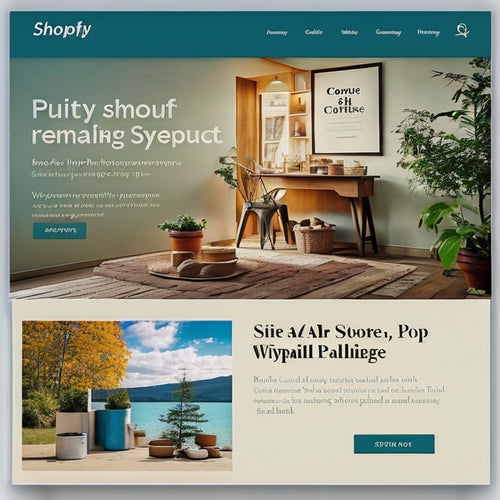
Create and Sell Digital Products That Delight Customers
Share
You want to create digital products that truly delight your customers, and it all starts with understanding who they are and what they need. Pinpoint your ideal buyer persona using real data, not assumptions, and craft your product around their pain points and goals. Validate your ideas through surveys and feedback to confirm you're meeting their needs. Then, plan engaging content, create high-quality digital assets, and develop a sales strategy that speaks to them. By setting competitive pricing and delivering exceptional customer experiences, you'll be well on your way to creating products that exceed their expectations, and now you're just one step closer to making it happen.
Key Takeaways
• Pinpoint your target audience through ideal buyer persona, rooted in real data, to create products that meet their needs and pain points.
• Develop a unique selling proposition that differentiates your digital product from competitors and resonates with your target audience.
• Craft high-quality, engaging, and interactive digital assets that cater to diverse learning styles and preferences.
• Set a competitive pricing strategy that reflects your product's value, development costs, and target audience's willingness to pay.
• Deliver exceptional customer experience through timely support, personalized communication, and seamless transactions to build trust and credibility.
Define Your Target Audience
To create a digital product that resonates with customers, you need to pinpoint who those customers are, and that starts by identifying your ideal buyer persona, a semi-fictional representation of your target audience based on real data and research. This persona should be rooted in reality, not assumptions.
To get started, you need to understand demographics - age, gender, income, occupation, and education level - to create a foundation for your persona. Next, research behavior patterns, such as purchasing habits, pain points, and goals. What motivates them? What problems do they face, and how can your product solve them?
By understanding these factors, you'll be able to craft a product that meets their needs and exceeds their expectations. Don't rely on guesswork or intuition; instead, gather data from surveys, customer feedback, and market research to inform your persona.
With a well-defined target audience, you'll be able to create a digital product that truly resonates with them, driving engagement, loyalty, and ultimately, revenue.
Identify Profitable Product Ideas
Now that you've pinpointed your ideal buyer persona, you can start brainstorming digital product ideas that address their pain points and align with their goals. It's time to get creative and think about what kind of digital products will resonate with your target audience.
To identify profitable product ideas, you'll need to conduct market research to stay on top of trends and understand what's currently in demand. This will help you differentiate your product from the competition and create something truly unique.
Here are a few strategies to get you started:
-
Analyze your competition: Research what they're offering and identify gaps in the market that you can fill.
-
Identify emerging trends: Stay ahead of the curve by keeping an eye on industry trends and adapting your product idea accordingly.
-
Validate your idea: Use surveys, focus groups, or social media to gauge interest in your product idea and make adjustments based on feedback.
Plan Engaging Course Content
You'll need a clear plan for your course content to guarantee it resonates with your target audience and drives results. This means understanding their pain points, goals, and motivations to create content that speaks directly to them. Start by outlining the key takeaways you want your students to walk away with, and then structure your content around those outcomes.
To keep students engaged, incorporate engaging visuals, such as infographics, videos, and images, to break up text and illustrate complex concepts. Interactive activities, like quizzes, discussions, and exercises, will also help students apply what they've learned and retain the information better.
Consider the 70:20:10 rule, where 70% of your content is educational, 20% is interactive, and 10% is inspirational. By striking the right balance, you'll create a course that's both informative and engaging, setting your students up for success and driving business results for you.
Create High-Quality Digital Assets
With your captivating course content planned, it's time to bring it to life with high-quality digital assets that cater to your students' diverse learning styles and preferences. You want to create assets that are visually appealing, easy to consume, and provide immense value to your students. This is where your graphic design skills come into play.
Invest time in designing eye-catching graphics, illustrations, and icons that break up text and make your content more engaging.
To take your digital assets to the next level, focus on the following:
-
Develop a consistent visual brand: Guarantee your digital assets align with your brand's overall aesthetic, including colors, typography, and imagery.
-
Invest in high-quality images and videos: Use stock images or create your own custom visuals that are high-resolution and relevant to your content.
-
Create interactive elements: Incorporate interactive elements like quizzes, games, and simulations to make your content more immersive and engaging.
Develop a Sales Strategy
How will you position your digital product to resonate with your target audience and drive sales? To create a successful sales strategy, you need to identify your unique selling proposition (USP), target audience, and marketing channels.
| Marketing Channel | Target Audience | Sales Strategy |
|---|---|---|
| Social Media | Millennials | Utilizing social media marketing to create engaging content and ads |
| Email Marketing | Professionals | Implementing automation tools to personalize and optimize email campaigns |
| Influencer Marketing | Young Adults | Partnering with influencers to promote digital products and reach a wider audience |
| Content Marketing | Entrepreneurs | Creating valuable content to educate and nurture leads |
| Paid Advertising | Business Owners | Running targeted ads to drive traffic and generate sales |
Set Competitive Pricing
After developing a sales strategy that resonates with your target audience, it's time to determine the best price for your digital product that will drive sales and stay competitive in the market.
You need to set a price that reflects the value proposition of your product and resonates with your target audience. Conducting a market analysis will help you identify your competitors and their pricing strategies, allowing you to position your product effectively.
Here are some key considerations to keep in mind when setting your price:
-
Research your competition: Analyze the prices of similar digital products to determine a fair and competitive price for your product.
-
Calculate your costs: Factor in the costs of creating and delivering your digital product, including development, marketing, and distribution expenses.
-
Test and refine: Test different price points with your target audience and refine your pricing strategy based on customer feedback and sales data.
Deliver Exceptional Customer Experience
You can greatly enhance customer loyalty and retention by delivering exceptional customer experience, which is vital to driving repeat business and encouraging positive word-of-mouth about your digital product.
To achieve this, you need to focus on enhancing interactions with your customers across all touchpoints. This means providing timely and effective support, offering personalized communication, and ensuring seamless transactions. By doing so, you'll build trust and credibility with your customers, leading to increased satisfaction and loyalty.
Data shows that loyal customers are five times more likely to repurchase, five times more likely to forgive, and four times more likely to refer. Building loyalty is key to accessing long-term growth and profitability.
To deliver exceptional customer experience, you must be customer-centric, empathetic, and proactive. Anticipate their needs, address their concerns, and exceed their expectations. By doing so, you'll create a loyal customer base that will drive your business forward.
Frequently Asked Questions
How Do I Protect My Digital Product From Piracy or Theft?
"Don't let your digital product become a sitting duck for pirates! You're wise to prioritize protection. Use copyright protection and encryption to lock it down, then add digital rights management and watermarking to track any unauthorized use."
Can I Sell Digital Products on My Existing Website or Blog?
You can definitely sell digital products on your existing website or blog, leveraging website integration tools to streamline sales and incorporating targeted marketing strategies to maximize conversions and boost customer engagement.
What if I'm Not Tech-Savvy, Can I Still Create Digital Products?
You don't need to be tech-savvy to create digital products; you can outsource help or take technology tutorials to learn. Focus on your strengths, like graphic design or content creation, and let others handle the rest.
How Do I Handle Customer Refunds or Disputes Effectively?
"You're not a fortune teller, but you can predict and prevent refund disputes by setting clear refund policies, focusing on customer satisfaction, and having a solid conflict resolution process in place to manage disputes efficiently."
Do I Need to Pay Taxes on Digital Product Sales Revenue?
You'll need to navigate tax implications on digital product sales revenue, considering deductions and international sales regulations, to guarantee compliance and maximize profits, while keeping customers' needs top of mind.
Related Posts
-
What Do Shopify Sitemap Apps Offer Your Store?
This article aims to provide an informative overview of the benefits and features offered by Shopify sitemap apps fo...
-
Shopify SEO: A Simple Guide for Beginners
This article provides a comprehensive guide on Shopify SEO for beginners. It explores the benefits of implementing S...
-

How Do I Make My Shopify Email Pop Up
This article explores the strategies and techniques involved in creating an effective Shopify email pop-up. By exami...
